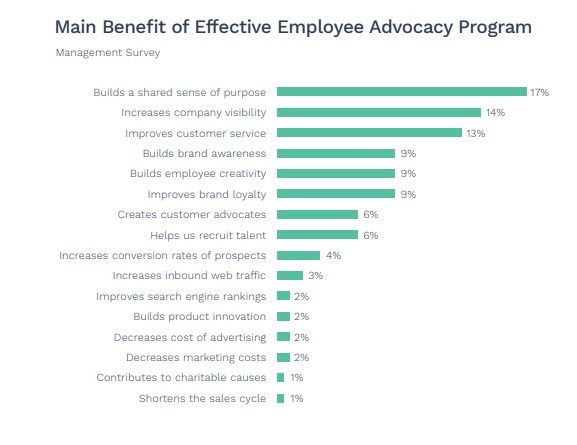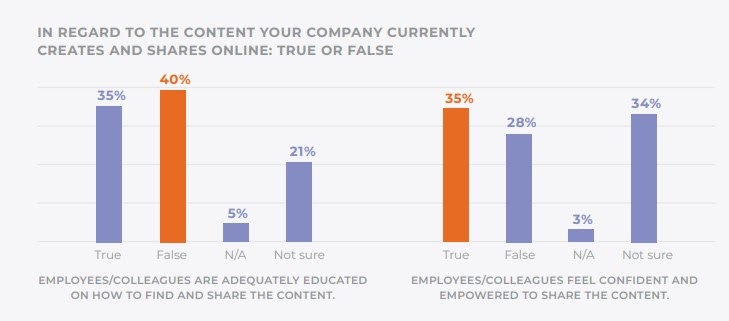The digital age has heralded in a new social phenomenon known as employee advocacy.
Regardless of the department that employees work in, they can be assets for marketing. Business owners have begun to realize how empowered employees can actually help their brands boost their engagement.
But can you turn your workforce into brand advocates?
In this podcast episode, the founder and CEO of GaggleAMP, Glenn Gaudet, discusses how brands can leverage employee advocacy. He specializes in employee advocacy technology and social media management.
Before we get into the details, let’s take a look at what employee advocacy is.
What is Employee Advocacy?
Employee advocacy focuses on empowering a workforce to drive brand exposure.
It’s about leveraging your employees’ reach and influence on social platforms. When your employees share your brand message, you can reach out to their friends and family. In this way, you can widen your reach.
According to a study, the main benefits of employee advocacy include building a shared sense of purpose and boosting company visibility. Other benefits include improving customer service and building brand awareness.
Image via PostBeyond
But what is a brand’s role in this strategy?
You have to make it easy for employees to share your branded content. You can do this by providing them with content they can share on their social networks.
Read on to learn how you can use employee advocacy to optimize your digital strategy.
How Can You Use Employee Advocacy to Turn Your Business into a Powerhouse?
Not sure how to get started with your employee advocacy program? In this article, we’ll take a closer look at the important steps that you need to follow to turn your employees into brand advocates.
Let’s get started…
1. Set the Goals of Your Employee Advocacy Program
Before you get started, determine what you want to achieve with employee advocacy. Do you want to increase reach, engagement, sales, or brand awareness?
Glenn recommends having employee advocacy goals that tie in with your overall digital and marketing strategy.
Remember:
Before you approach your employees, be clear about your goals. Based on them, create quality content. Don’t just make it company-centric. Add a healthy mix of industry-related content, third party content, and entertaining content.
Why?
Because you want to keep your employees and followers engaged. If your content seems overly promotional, your employees may not want to share it.
And you shouldn’t force them to share your content.
Instead, your content should be so awesome that they will want to share it willingly. So, make sure it aligns with their overall interests.
2. Create a Focus Group
When you’re starting your employee advocacy program, be realistic with your expectations. Do not expect everyone to be on board right away. Instead, create a strategy to get everyone engaged step by step.
Start by identifying a group of employees who can help you with your goals. Include the employees who are the most active on social media in your focus group.
Then expand to other employees as the employee advocacy program continues to grow.
Encourage senior employees to participate as well so that they can lead by example.
3. Educate and Train Your Employees
Most companies without an employee advocacy program have policies that govern how employees should handle posting about the company on social media.
In most cases, the majority of employees are not allowed to contribute or post anything about the company.
Only two or three employees have the authority to say anything on social media about the company.
In a report by Social Media Today sponsored by GaggleAMP, more than 39% of employees don't have adequate training on advocacy. Only 35% of employees were confident in what they could say about their brand on social media.
Image via Social Media Today
What is Glenn’s opinion on this?
The world is a different place now. Everybody is talking to everybody today. You can leverage employee advocacy and use it to empower employees.
Or you can keep your head buried in the sand and let your competitors have all of those conversations and engagements.
By educating and training employees, you equip them with the right kind of content to share on social media.
Do not assume that everyone knows how to use social media.
Instead, hold training sessions that equip employees with the necessary social media skills. Include training on how to open an account, social media guidelines, and how to build their personal brands.
These skills will arm them so that they know how to respond and what kind of content it’s OK to share.
Give the employees a tour of the brand's social pages. Let them know what your social media goals are, who your key audiences are, and who your competitors are.
Also walk them through the types of content you commonly share and why. Keep them informed about any guidelines or marketing activities, so that they are always up-to-date.
Update your policy too, so that it is not only about what they cannot do.
Include information on what employees can post, as well as how they should identify themselves, and the roles they hold at the company.
Include training on how to answer questions, feedback, and mentions using examples.
Use this opportunity to also demonstrate value to them. By sharing company content, the employees can build their professional reputations too. They can increase their own visibility as well and, with time, can become thought leaders in your industry.
4. Launch Your Employee Advocacy Program
Once you’ve trained your employees and set your goals, you’re set to launch your campaign.
Glenn’s advice is to leverage your subject matter employees first and then expand it to others.
Who are subject matter employees?
Employees with deep knowledge about particular topics.
You should also make it easy for employees to share your content so that you get the highest impact.
How can you do that?
- Create content employees will not only want to share, but that is relevant to their followers.
- Inform them that they are not under pressure to share and that they will still have control over their accounts.
- Continuously train employees and remind them to share content.
- Ensure there is open communication during the launch and take feedback positively.
- Include the program as one of the agendas in meetings and get feedback from employees on their experience.
Leveraging an employee advocacy tool can come in handy. Employees can then receive regular reminders to share. The tool will also, with time, learn what content every employee is comfortable sharing and share more of that with them.
5. Measure Employee Advocacy Results
It’s essential to track the success of your employee advocacy program. Find out whether employees are fully on board with the program.
Has the content engagement rate risen? What kind of content is driving more engagement, and on which platforms?
Employee advocacy tools like LinkedIn Elevate, GaggleAMP, and others can help you track the results of your employee advocacy program. Keep an eye on important metrics like active users and share rates.
Also, take a look at the demographics of engaged audiences, and the overall page views. You can also track your ROI and whether the program has led to increased traffic and sales.
Ready to Get Started with Employee Advocacy?
Make your employees your biggest advocates and watch your business grow. Consider how many employees you have and see the opportunity in each of their untapped audiences.
If you train them well, they can help you to increase your reach and engagement on social media.
Do you have any questions about employee advocacy programs? Please share them in the comments section. I’ll be happy to help answer them for you.

Shane Barker is a digital marketing consultant who specializes in influencer marketing, product launches, sales funnels, targeted traffic, and website conversions. He has consulted with Fortune 500 companies, influencers with digital products, and a number of A-List celebrities.









